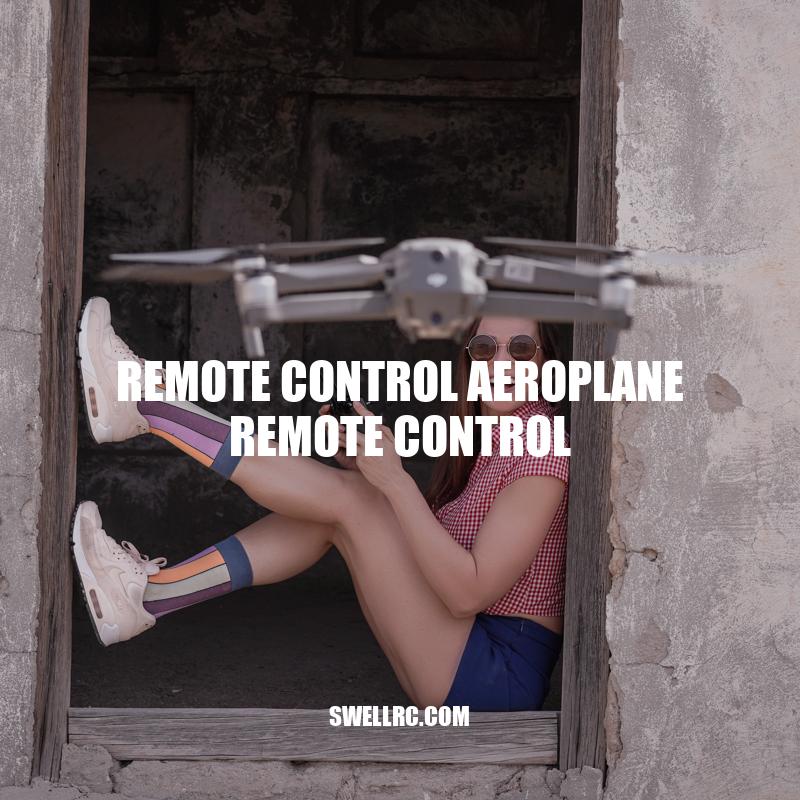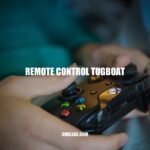Remote Control Aeroplanes: A Guide to Usage, Types, and Maintenance
Remote control aeroplanes are fantastic gadgets that let you explore the world of aviation from a new perspective. Whether you’re a seasoned pilot or a hobbyist, flying a remote control aeroplane is exciting, fun, and rewarding. However, before you take to the skies, it’s essential to understand how these planes work and how to operate them safely and effectively. In this article, we’ll provide comprehensive insights into remote control aeroplanes, including their components, types, and flying and maintenance tips. By the end, you’ll have gained sufficient knowledge to take on the skies and enhance your remote control aeroplane experience.
Types of Remote Control Aeroplanes
Remote control aeroplanes come in various shapes, sizes, and types, each designed for specific purposes. Understanding the types of remote control aeroplanes can help you choose the best one for your needs. Here are some common types:
- Fixed-wing planes: These are the most common type of remote control aeroplanes. They feature a fixed-wing design and are suitable for open spaces. They come in various sizes, from small models that fit in your palm to large-scale planes suitable for flying competitions.
- Helicopters: Remote control helicopters are more challenging to fly but offer greater control and manoeuvrability. They’re ideal for indoor spaces and are available in various designs and with different features.
- Drones: Remote control drones have gained immense popularity in recent times. They’re designed for aerial photography and videography as well as for racing or other recreational activities.
Each of these types has its pros and cons, so it’s important to choose one that fits your needs and preferences. You can find remote control aeroplanes on various websites and stores. However, it’s essential to do some research and read reviews before making a purchase to ensure you get the best quality and value for your money.
How do remote controlled airplanes work?
Remote controlled airplanes work by receiving signals from a handheld control device that transmits wirelessly to a receiver within the plane. This receiver then converts the signals into commands to control the plane’s motor(s), servos, and other components.
A typical remote control airplane system consists of the following components:
| Handheld Controller | Transmitter |
| Receiver | Airplane |
The controller sends commands to the transmitter, which uses a radio frequency to send the signal to the receiver. The receiver then interprets the signal and uses an onboard computer to communicate with the airplane’s different components.
Some popular websites for remote control airplanes include Horizon Hobby and RC Groups. Popular products include the E-flite UMX Radian, HobbyZone Sport Cub S, and the DJI Mavic Air 2 drone.
- Horizon Hobby – https://www.horizonhobby.com/category/airplanes/
- RC Groups – https://www.rcgroups.com/aircraft-electric-general-e-planes-16/
- E-flite UMX Radian – https://www.horizonhobby.com/product/airplanes/umx-airplanes/bind-n-fly/radian-bnf-eflU2980
- HobbyZone Sport Cub S – https://www.horizonhobby.com/product/airplanes/sport-rc-airplanes/sport-cub-s-2-rtf-hbz4400
- DJI Mavic Air 2 – https://www.dji.com/mavic-air-2
Components of a Remote Control Aeroplane
Remote control aeroplanes are composed of several components that work together to achieve flight. Understanding each component’s role is crucial when flying and maintaining a remote control aeroplane. Here are the essential components:
| Component | Description |
|---|---|
| Transmitter | The hand-held device that sends signals to the receiver. |
| Receiver | Receives the signals from the transmitter and sends them to the other components of the aeroplane. |
| Servos | Small actuators that control the movement of the control surfaces, such as the rudder, elevator, and ailerons. |
| Motor | The power source that drives the propeller or rotor blades to generate thrust. |
| Battery | Provides power to the motor and other electronic components of the aeroplane. |
Other components that are not part of the essential set-up include:
- Flight controller: Helps to stabilize the aeroplane during flight and assists with manoeuvring.
- Camera: Attached to drones for aerial photography and videography purposes.
- GPS: Provides location tracking and navigation assistance.
Understanding the function of each component and ensuring that they’re functioning correctly is essential when operating a remote control aeroplane. You can find the quality components you need for your remote control aeroplane on various websites and stores, but always remember to read reviews from other users before making a purchase. Check out Horizon Hobby for a wide range of high-quality remote control aeroplane components.
How does a remote control airplane work?
A remote control airplane works by using a transmitter to send signals to a receiver on the plane. These signals control the airplane’s throttle, elevator, rudder, and ailerons, allowing the pilot to steer and maneuver the plane from a distance. The transmitter communicates with the receiver using radio waves and a specific frequency.
Some remote control airplanes also feature advanced technology, such as gyroscopes and stabilization systems, which help to improve control and stability in flight.
If you’re interested in learning more about remote control airplanes, websites such as Hobbyking.com and HorizonHobby.com offer a wide range of products, as well as articles and forums where hobbyists can discuss tips, tricks, and new developments in this exciting field.
Flying a Remote Control Aeroplane
Flying a remote control aeroplane can be an enjoyable activity, but it comes with its own set of challenges. Here are some things to keep in mind when flying your remote control aeroplane:
- Before flying, perform a pre-flight check to ensure the aeroplane’s components are functioning correctly.
- Always fly in an open and safe area, away from airports and restricted zones. Ensure there is no one else in the vicinity.
- Start by flying your aeroplane at low altitudes and gradually build up to higher altitudes as you gain confidence.
- Keep your eyes on the aeroplane and avoid distractions. Remember to stay focused until the aeroplane is safely landed.
- Be mindful of weather conditions, and avoid flying during windy or rainy weather conditions.
- Always follow the manufacturer’s instructions and guidelines when flying your aeroplane.
- Invest in a simulator to practice flying, particularly if you’re a beginner.
- Join a club or group of other remote control aeroplane enthusiasts to learn from and fly with other experienced pilots.
You can find many online resources devoted to flying remote control aeroplanes, including forums and instructional videos that provide tips and guidelines on how to fly safely. Some websites also offer remote control aeroplane models for purchase, along with comprehensive manuals and customer support. Remember that with practice and proper technique, anyone can learn how to fly remote control aeroplanes like a pro.
Is it hard to fly remote control plane?
Flying a remote control plane can be challenging at first, but it largely depends on the type of plane and your level of experience. Some planes are easier to fly than others, especially if they have beginner-friendly features like stabilization systems or simplified controls. However, even the easiest planes require a certain level of skill and knowledge to fly properly. Here are some factors that can affect the difficulty of flying a remote control plane:
- The type of plane – some planes are designed for beginners while others are meant for more experienced pilots
- The size of the plane – larger planes can be harder to control
- The control options – planes with more complex controls will take longer to master
- The environment – flying in windy conditions or in a crowded area can make flying more difficult
If you’re new to flying remote control planes, it’s a good idea to start with a basic trainer plane or seek guidance from experienced pilots. You can also find helpful information on websites like RCGroups.com or in instructional books and videos. Additionally, certain products like flight simulators can help you practice flying without the risk of crashing your real plane.
Maintaining Your Remote Control Aeroplane
Maintaining your remote control aeroplane is essential to ensure it lasts long and remains in good condition. Here are some tips to keep in mind when it comes to maintaining your remote control aeroplane:
- After each flight, clean your aeroplane using a soft brush and a dry cloth to remove any dirt and debris.
- Remove the battery from the aeroplane and place it in a secure and dry area. The battery should be fully charged before storage.
- Store your aeroplane in a dry and safe place, away from moisture and dust. Consider using a storage box or a carry bag to protect the plane when not in use.
- Inspect your aeroplane before each flight to ensure all components and attachments are intact and working correctly.
- Replace any worn-out parts immediately to prevent further damage to your aeroplane.
- Invest in a maintenance kit that includes spare parts and tools necessary to carry out repairs and maintenance on your aeroplane.
- Check the manufacturer’s guidelines for recommended cleaning and maintenance procedures.
Proper maintenance can help prolong the lifespan of your remote control aeroplane and ensure it remains in good working condition. There are many online forums and websites that provide tips and guidelines on how to clean and maintain remote control aeroplanes. You can also purchase maintenance kits and spare parts from these websites to keep your aeroplane in top condition.
How do you balance a remote control airplane?
Balancing a remote control airplane requires adjusting the weight distribution to ensure it flies straight and stable. Here are the steps to follow:
- Start by checking the balance point of the plane, which should be listed in the manual or instructions.
- Next, use a small weight like a coin or a piece of tape to test the balance of the plane. Place the weight at the recommended balance point and see if the plane tilts to one side or the other.
- If the plane is not balanced, adjust the weight distribution accordingly. You may need to add or remove weight to get it just right.
- Test the plane again after each adjustment to see if it’s flying straight and level.
- Keep adjusting until the plane is balanced and flying smoothly.
There are various websites and forums available that provide helpful tips and tutorials on remote control airplanes balancing. You can also find balancing products such as digital scales and balancing stands on hobby websites like Horizon Hobby or Tower Hobbies.
Conclusion
Flying a remote control aeroplane can be a fascinating hobby, but it comes with responsibilities. As mentioned earlier, proper training, regular practice, and following safety guidelines are crucial to enhance your flight experience. Always prioritize safety in all your flights, and minimize the risk of injuring yourself or damaging your aeroplane. By understanding how remote control aeroplanes work, the different types available, the critical components, and maintenance practices, you can maximize your flying sessions and become a skilled pilot. The hobby can also be a great way to connect with other enthusiasts through online forums, groups, and events. Through constant learning, innovation, and creativity, remote control flying will continue to grow in popularity, and advancements in technology will continue to push the boundaries of aeroplanes in the sky.



